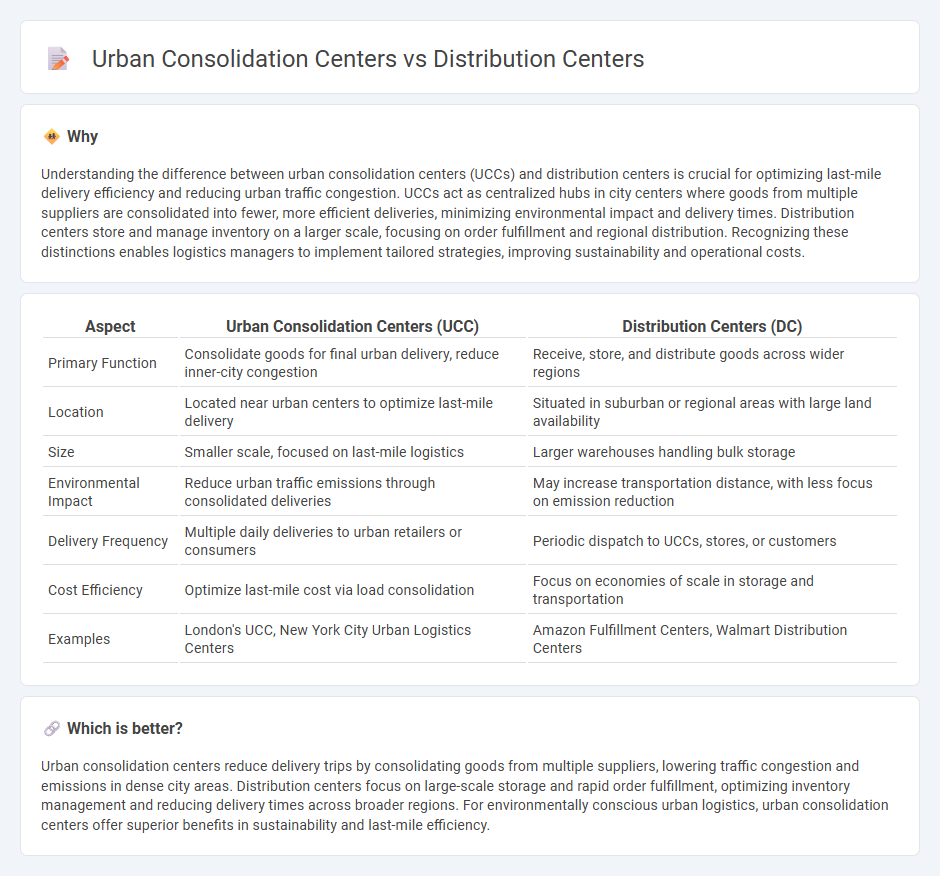
Urban consolidation centers (UCCs) optimize last-mile delivery by aggregating shipments from multiple suppliers, reducing traffic congestion and emissions in city centers. In contrast, distribution centers focus on storing, sorting, and dispatching goods to various locations, emphasizing inventory management and bulk handling efficiency. Explore the advantages of UCCs compared to traditional distribution centers to enhance urban logistics strategies.
Why it is important
Understanding the difference between urban consolidation centers (UCCs) and distribution centers is crucial for optimizing last-mile delivery efficiency and reducing urban traffic congestion. UCCs act as centralized hubs in city centers where goods from multiple suppliers are consolidated into fewer, more efficient deliveries, minimizing environmental impact and delivery times. Distribution centers store and manage inventory on a larger scale, focusing on order fulfillment and regional distribution. Recognizing these distinctions enables logistics managers to implement tailored strategies, improving sustainability and operational costs.
Comparison Table
| Aspect | Urban Consolidation Centers (UCC) | Distribution Centers (DC) |
|---|---|---|
| Primary Function | Consolidate goods for final urban delivery, reduce inner-city congestion | Receive, store, and distribute goods across wider regions |
| Location | Located near urban centers to optimize last-mile delivery | Situated in suburban or regional areas with large land availability |
| Size | Smaller scale, focused on last-mile logistics | Larger warehouses handling bulk storage |
| Environmental Impact | Reduce urban traffic emissions through consolidated deliveries | May increase transportation distance, with less focus on emission reduction |
| Delivery Frequency | Multiple daily deliveries to urban retailers or consumers | Periodic dispatch to UCCs, stores, or customers |
| Cost Efficiency | Optimize last-mile cost via load consolidation | Focus on economies of scale in storage and transportation |
| Examples | London's UCC, New York City Urban Logistics Centers | Amazon Fulfillment Centers, Walmart Distribution Centers |
Which is better?
Urban consolidation centers reduce delivery trips by consolidating goods from multiple suppliers, lowering traffic congestion and emissions in dense city areas. Distribution centers focus on large-scale storage and rapid order fulfillment, optimizing inventory management and reducing delivery times across broader regions. For environmentally conscious urban logistics, urban consolidation centers offer superior benefits in sustainability and last-mile efficiency.
Connection
Urban consolidation centers optimize last-mile logistics by centralizing goods from multiple suppliers to reduce delivery trips and congestion. Distribution centers serve as primary hubs where inventory is stored, sorted, and dispatched to urban consolidation centers for final delivery. This interconnection enhances efficiency, lowers transportation costs, and minimizes environmental impact in urban freight movements.
Key Terms
Inventory Management
Distribution centers optimize inventory management by storing large quantities of goods in strategically located warehouses to facilitate efficient order fulfillment and reduce transportation costs. Urban consolidation centers focus on inventory aggregation from multiple suppliers in city centers, minimizing delivery trips and lowering urban congestion while enabling just-in-time inventory practices. Explore how blending both models can streamline stock control and enhance supply chain sustainability.
Last-Mile Delivery
Distribution centers serve as large-scale facilities where goods are received, stored, and shipped to retailers or end customers, supporting mass inventory management and regional logistics. Urban consolidation centers operate within city limits, aggregating multiple shipments to optimize last-mile delivery by reducing vehicle trips, congestion, and emissions. Explore how integrating these centers enhances efficient, sustainable urban logistics.
Freight Consolidation
Distribution centers serve as large-scale hubs where goods are received, stored, and dispatched to various locations, optimizing inventory management and reducing delivery times. Urban consolidation centers focus specifically on freight consolidation by aggregating shipments from multiple suppliers into fewer, more efficient last-mile deliveries within dense urban areas, minimizing traffic congestion and emissions. Explore our insights to understand how freight consolidation enhances supply chain efficiency.
Source and External Links
Distribution Centers Explained - NetSuite - Distribution centers are logistics facilities that store finished goods before they're picked and packed to fulfill customer orders, and they serve various clients such as retailers, consumers, or both, often optimizing for automation technology.
Logistics Distribution Center (DC): What is it and its functions? - A distribution center is a logistics building designed to receive, store, and ship goods efficiently, strategically located near cities and transport links to reduce delivery times and costs.
Distribution center - Wikipedia - Distribution centers are specialized warehouses organized into receiving, storage, and shipping areas, planned for efficiency with considerations such as conveyor systems and product handling to manage inventory flow effectively.
 dowidth.com
dowidth.com